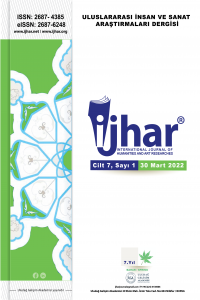Abstract
1980 yılından itibaren artan kontrolsüz kapitalizm ile birlikte toplumlar kamu değerlerini yavaş yavaş yitirmeye başlamışlardır. Kişisel çıkarların öne çıkıp, toplumsal korumaya muhtaç ya da tüketim kültürüne katılmayan insanların yok sayıldığı bu yeni dönem yeni-kapitalist düzen olarak nitelendirilmektedir. Bu dönemde ortaya çıkan “Atık İnsan” veya “Iskarta İnsan” kavramı yurttaşlık yerine tüketici kavramı üzerine temellenmektedir. Sadece gelir değil, dijital ve ekolojik olarak da eşitsizlik toplumun bu kısmında yaygındır. Zenginle fakir arasındaki uçurumun gittikçe arttığı günümüz dünyasında atık insanların sayısı her geçen gün çoğalmaktadır. Atık insan kavramı çeşitlidir: Gözden düşmüş meslek sahipleri, göçmenler, bakıma muhtaçlar, tüketim yapmayanlar, işsizler, dış görünüş olarak toplumsal normlara uymayanlar olarak örnek verilebilir. Toplumların eskiden yasal olarak koruduğu bu insanlar kullan-at ürünlerine hatta doğrudan atık olarak sınıflandırılmaktadırlar. Topluma yük olarak görülen bu insanlar sıkı bir gözetim altına da alınmak istenmektedirler. Günümüz sanatında atık insan sorunsalı sanatçıların ele aldığı bir konu olmuştur. Modern hayatın bir ürünü olan atık insan kavramının güncel sanatta ele alınışı oldukça geniştir. Kirli hava ve kötü bir ekolojik çevrede yaşayan, kimyasal atıklara ve hastalıklara çoğu zaman maruz kalan bu ıskarta insanların bedenleri de standart beden tanımını değiştirmiştir. Günümüz postmodern çağda bu atık insan bedenleri klasik beden imgesini yıkıp öte-insan bedenleri olarak da tanımlanmıştır. Çalışmanın amacı atık insan kavramını sosyolojik olarak irdeleyip günümüz sanatında ele alınışını incelemektir. Bu amaç doğrultusunda makalenin giriş kısmında atık insan kavramı sosyolojik olarak açıklanıp, daha sonraki başlıkta güncel sanatçıların atık insan kavramı ile ilgili çalışmalarına yer verilecektir.
Keywords
References
- Chul Han, B. (2017). Psikopolitika (çev. Haluk Barışcan), İstanbul: Metis Yayınları.
- Chul Han, B. (2020). Kapitalizm ve Ölüm Dürtüsü (çev. Çağlar Tanyeri), İstanbul: İnka Yayınları.
- Bauman, Z. (2020). Postmodern Etik (çev. Alev Türker), İstanbul: Ayrıntı Yayınları.
- Bauman, Z. (2018). Iskarta Hayatlar (çev. Osman Yener), İstanbul: Can Yayınları.
- Giroux, H. A. (2018). Toplumun Alacakaranlığı (çev. Ümit Hüsrev Yolsal), Ankara: Dost Kitapevi.
- Beck, U. (2011). Risk Toplumu (çev. Kazım Özdoğan ve Bülent Doğan), İstanbul: İthaki Yayınları.
- Farthing, S. (2012). Sanatın Tüm Öyküsü (çev. Gizem Aldoğan ve Firdevs Candil Çulcu), İstanbul: Hayalperest Yayınları.
- Blessing, J. (2015). Body of Art, New York: Phaidon Press.
- Fineberg, J. (2014). 1940’dan Günümüze Sanat Varlık Stratejileri (çev. Simber Atay Eskier ve Göral Erinç Yılmaz), İzmir: Karakalem Yayınları.
- Yazgünoğlu, K. C. (2020). Öte-İnsan Bedenleri: Nesneler, Ekolojiler ve Moleküller. Pasajlar Sosyal Bilimler Dergisi , 3(7): 118-123.
Abstract
With the restructuring of capitalist culture in the 1980s, both social and political balances have changed. Social dynamics have deteriorated as a result of increased capitalism and more production. The balance of power in society has changed, and the concept of globalization has begun to be included in our lives. In this period, the collapse of socialism, which challenged the capitalist system throughout the 20th century, caused capitalism to become an unrivaled world system (Şaylan, 2020: 170). In this new world order, the perceptions of people and society have changed. The goal of continuous growth, the lack of economic control has dragged humanity into a brutal competitive environment, and the gap between the rich and the poor has widened. Although income inequality was at its historical peak in this period, the rich claimed that they had no responsibilities to the rest of the society (Giroux, 2018: 74). At this point, where human values have been lost, the segment of society that is called needy (the poor, the homeless, the sick) has begun to be seen as a burden. In addition, people of different genders, races and classes who do not comply with the economic interests of the society are also considered a burden and labeled as "disappearing". For this reason, today, instead of the holistic concept of "citizenship", there is a "consumer" approach. At the end of the increasing consumption action, the class and people who cannot adapt to this can be thrown out or, as Zygmunt Bauman puts it, the concept of "waste human" (Bauman, 2007: 28). Especially refugees, immigrants, the poor and those who cannot adapt to globalization are included in this mold. These communities benefit not only from the economy but also from the conditions in nature (air, water, soil) unequally. Pollution and levels of toxins in air, water and soil are linked to unequal wealth distribution. Peoples and communities with higher income levels are trying to be affected by this poisoning with less damage and in an acceptable (?) way. Toxic foods, high radiation, toxic products are offered to a certain group of people by ignoring the dangers (Beck, 2011: 109-116).Now, instead of a pure concept of "nature" in the 21st century, it becomes a place that becomes artificial with synthetic, economic and political rents. Nature, which has fed people throughout history, has taken its share from the consumer society and almost poisoned its consumers. Therefore, we can also call the individual living in the 21st century as “Posthuman” or “Posthuman”. The "human and body" oriented approach in the classical period was destroyed in the post-modern era. Because external intervention to the individual is quite high. Now, humans are a whole with viruses, plants, nature, consumables, air, the city they live in (Yazgünoğlu, 2020: 120). The other-human carries a sick, dirty existence created by virtuality, technology and interaction with artificial nature. The other-human has similarities with the waste human concept we mentioned above. The individual, who survived in a toxic way in the 21st century, is no longer the beauty or idealism of Ancient Greece or the Renaissance. The feeling of loss and misfortune is the main character of globalization (Bauman, 2018: 81). The individual of the 21st century is in a state of constant anxiety, his body is exposed to radiation and viruses. If the society does not adapt to consumption, they enter the “out of the system” and “unhelpful” segments and become almost discarded and waste. This situation of human beings, which has almost turned into a hybrid species in terms of bodily existence, has become a subject that today's artists and thinkers deal with.
Keywords
References
- Chul Han, B. (2017). Psikopolitika (çev. Haluk Barışcan), İstanbul: Metis Yayınları.
- Chul Han, B. (2020). Kapitalizm ve Ölüm Dürtüsü (çev. Çağlar Tanyeri), İstanbul: İnka Yayınları.
- Bauman, Z. (2020). Postmodern Etik (çev. Alev Türker), İstanbul: Ayrıntı Yayınları.
- Bauman, Z. (2018). Iskarta Hayatlar (çev. Osman Yener), İstanbul: Can Yayınları.
- Giroux, H. A. (2018). Toplumun Alacakaranlığı (çev. Ümit Hüsrev Yolsal), Ankara: Dost Kitapevi.
- Beck, U. (2011). Risk Toplumu (çev. Kazım Özdoğan ve Bülent Doğan), İstanbul: İthaki Yayınları.
- Farthing, S. (2012). Sanatın Tüm Öyküsü (çev. Gizem Aldoğan ve Firdevs Candil Çulcu), İstanbul: Hayalperest Yayınları.
- Blessing, J. (2015). Body of Art, New York: Phaidon Press.
- Fineberg, J. (2014). 1940’dan Günümüze Sanat Varlık Stratejileri (çev. Simber Atay Eskier ve Göral Erinç Yılmaz), İzmir: Karakalem Yayınları.
- Yazgünoğlu, K. C. (2020). Öte-İnsan Bedenleri: Nesneler, Ekolojiler ve Moleküller. Pasajlar Sosyal Bilimler Dergisi , 3(7): 118-123.
Details
| Primary Language | Turkish |
|---|---|
| Journal Section | Review |
| Authors | |
| Publication Date | March 30, 2022 |
| Submission Date | November 13, 2021 |
| Acceptance Date | March 8, 2022 |
| Published in Issue | Year 2022 Volume: 7 Issue: 1 |




International Journal of Human and Art Studies İJHAR; Licensed under the Creative Commons Attribution 4.0 International License.
International Journal of Human and Art Studies IJHAR has been registered with the decision of the Turkish Patent and Trademark Office, numbered 71248886-2020/24446 / E.2020-OE-458377.


